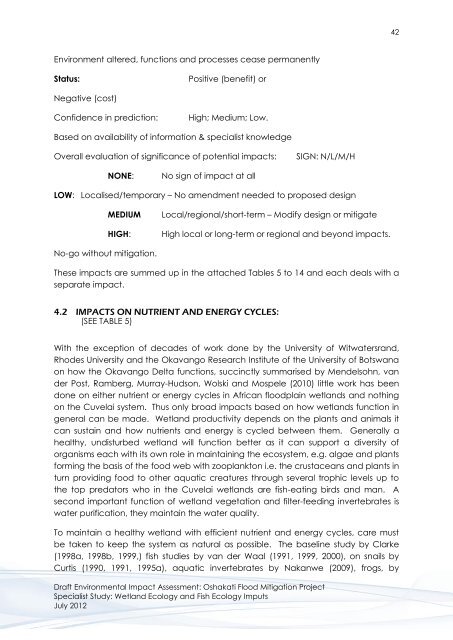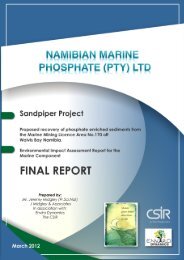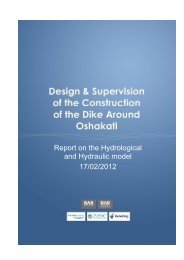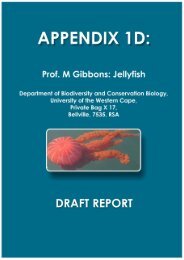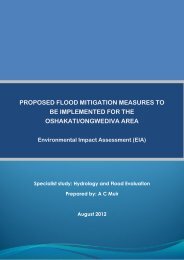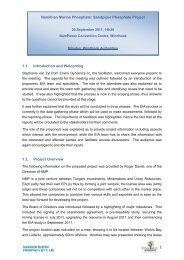Wetland & Fish Ecology - Enviro Dynamics Namibia
Wetland & Fish Ecology - Enviro Dynamics Namibia
Wetland & Fish Ecology - Enviro Dynamics Namibia
You also want an ePaper? Increase the reach of your titles
YUMPU automatically turns print PDFs into web optimized ePapers that Google loves.
42<br />
<strong>Enviro</strong>nment altered, functions and processes cease permanently<br />
Status:<br />
Positive (benefit) or<br />
Negative (cost)<br />
Confidence in prediction:<br />
High; Medium; Low.<br />
Based on availability of information & specialist knowledge<br />
Overall evaluation of significance of potential impacts:<br />
SIGN: N/L/M/H<br />
NONE:<br />
No sign of impact at all<br />
LOW: Localised/temporary – No amendment needed to proposed design<br />
MEDIUM<br />
HIGH:<br />
Local/regional/short-term – Modify design or mitigate<br />
High local or long-term or regional and beyond impacts.<br />
No-go without mitigation.<br />
These impacts are summed up in the attached Tables 5 to 14 and each deals with a<br />
separate impact.<br />
4.2 IMPACTS ON NUTRIENT AND ENERGY CYCLES:<br />
(SEE TABLE 5)<br />
With the exception of decades of work done by the University of Witwatersrand,<br />
Rhodes University and the Okavango Research Institute of the University of Botswana<br />
on how the Okavango Delta functions, succinctly summarised by Mendelsohn, van<br />
der Post, Ramberg, Murray-Hudson, Wolski and Mospele (2010) little work has been<br />
done on either nutrient or energy cycles in African floodplain wetlands and nothing<br />
on the Cuvelai system. Thus only broad impacts based on how wetlands function in<br />
general can be made. <strong>Wetland</strong> productivity depends on the plants and animals it<br />
can sustain and how nutrients and energy is cycled between them. Generally a<br />
healthy, undisturbed wetland will function better as it can support a diversity of<br />
organisms each with its own role in maintaining the ecosystem, e.g. algae and plants<br />
forming the basis of the food web with zooplankton i.e. the crustaceans and plants in<br />
turn providing food to other aquatic creatures through several trophic levels up to<br />
the top predators who in the Cuvelai wetlands are fish-eating birds and man. A<br />
second important function of wetland vegetation and filter-feeding invertebrates is<br />
water purification, they maintain the water quality.<br />
To maintain a healthy wetland with efficient nutrient and energy cycles, care must<br />
be taken to keep the system as natural as possible. The baseline study by Clarke<br />
(1998a, 1998b, 1999,) fish studies by van der Waal (1991, 1999, 2000), on snails by<br />
Curtis (1990, 1991, 1995a), aquatic invertebrates by Nakanwe (2009), frogs, by<br />
Draft <strong>Enviro</strong>nmental Impact Assessment: Oshakati Flood Mitigation Project<br />
Specialist Study: <strong>Wetland</strong> <strong>Ecology</strong> and <strong>Fish</strong> <strong>Ecology</strong> Imputs<br />
July 2012


